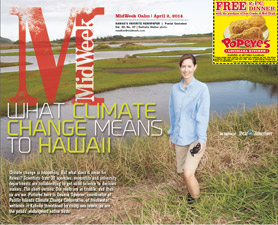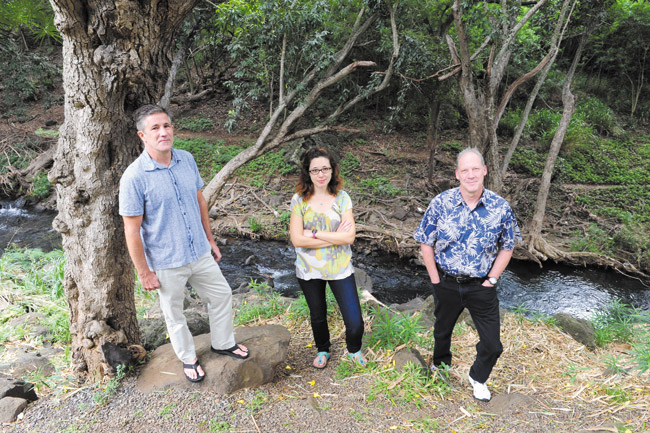What Climate Change Means To Hawaii
Climate change is happening. But what does it mean for Hawaii? Scientists from 30 agencies, nonprofits and university departments are collaborating to get solid science to decision makers. The short version: Our reefs are in trouble, and thus so are we
Climate change – we all discuss it.
On bar stools, in coffee shops and around the dinner table, we all put forth our thoughts on the matter.
mw-cover-040214-pacific-climate-1
The non-believers scoff at global warming with the coming of the winter snows, pointing to the polar vortex as the stigmata of their belief.
The Chicken Littles on the other side use the anecdotal evidence of backyards and barbecues washing away on the North Shore as the last step before the apocalypse.
Truth is, 99.999 percent of us have no idea what the heck we are talking about; we just have an opinion and a First Amendment right to express it.
This is a story about the .001 percent in Hawaii who know exactly what they are talking about, collectively known as Pacific Islands Climate Change Cooperative (PICCC).
It is made up of 30 different agencies, nonprofits and university departments that voluntarily partner up to work on climate adaptation for those agencies that manage natural and cultural resources.
“All of us really want to develop a better understanding of how climate change is impacting the region in general, and specifically Hawaii and the other U.S.-affiliated Pacific Island jurisdictions, and translate that understanding into an ability for our partners to adapt to those changes,” says Deanna Spooner, PICCC coordinator.
“People think of the ‘king tides’ in the Marshall Islands (that flooded homes and displaced hundreds of residents), but climate change is playing in a theater right next to you. But it is more subtle how it is impacting Hawaii right now.”
One of the ways PICCC is addressing these issues here in the Pacific is the newly formed U.S. Department of the Interior’s Pacific Islands Climate Science Center (CSC), directed by David Helweg. Based out of the University of Hawaii at Manoa, it is one of eight regional CSCs that are established and managed by the U.S. Geological Survey to provide federal, state and local land managers access to the best science available on climate change.
“A great deal of science has been very high quality, but it has not been translated to who is going to use it to make decisions. And even though it is about climate, it is really a people program, and we have to get the information to people so they can use it,” says Helweg.
To put it another way, fellow PICCCer John Marra likes to use the analogy of electricity.
“Our point is to create actionable information to support decision making, so how do you make that happen?” says Marra, NOAA Climate Services director for the Pacific Region.
“You need generators, transformers and transmitters. Generators are the folks who have the fundamental science to create useful information. Transformers take that information and put it in a format that folks can relate to, and then transmitters are the ones who take it out into communities and talk to the managers. We are the electricians trying to make all the connections between those pathways.”
So what is this information that they need to get out?
Some of it is a bit esoteric to most of us, looking at things such as the impact of saltwater inundation in freshwater wetlands on the North Shore and how that will affect the endangered bird population in the James Campbell Wildlife Refuge.
But others are much closer to home, like what is happening to our coral reefs.
“We are so dependent on them as an island people; our identity is connected to the oceans,” says Spooner. “What is happening with our coral reefs is a huge concern. As a lot of local people like to say, ‘That is our icebox.'”
The connections for us don’t stop there. Warmer, more-acidic ocean water leads to a breakdown of these reefs, killing not just a natural wonder that brings us billions of tourism dollars, but our first line of defense against the increasingly large storms that are headed our way in future years.
“As they break down, our first line of protection is breaking down, which means our shorelines and beaches are going to become more vulnerable,” warns Spooner. “And from there you have the cascading effect of more vulnerable roads, power plants and airports.”
Saltwater is not the only issue. As has been seen in recent years with California’s droughts, fresh water is becoming harder and harder to come by. But unlike our neighbors to the east, we only have one option for the basis of life.
“We are 100 percent dependent on rainfall for our water – not just us but our forests and all the creatures in our forests, our agricultural and even our tourism industry are all dependent on water,” says Spooner. “We can’t build a pipeline to California, so as rainfall patterns change, we have to adjust.”
All the science in the world will not help alleviate these problems without the people in charge having the information they need to make changes in how we live. It is the governor and our representatives who can enact change, and this is the area that PICCC is trying to improve upon.







